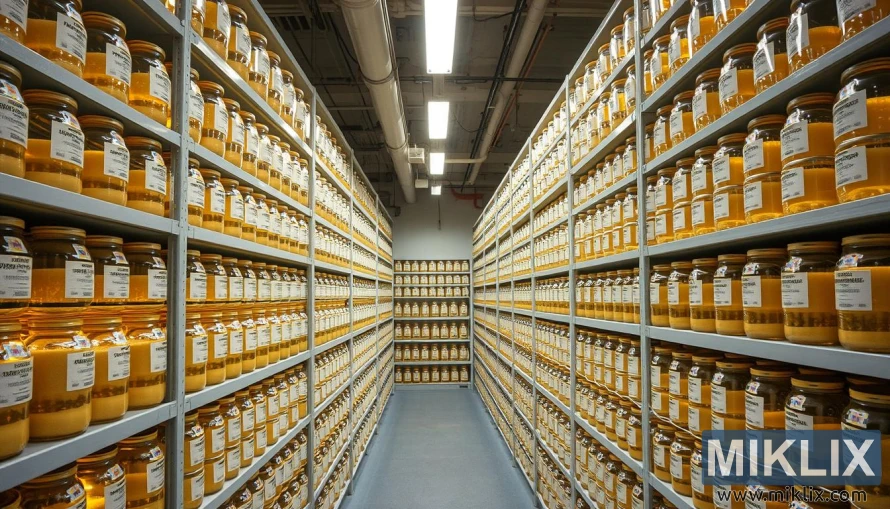Image: Yeast Storage Room
Published: July 23, 2025 at 6:32:58 AM UTC
Last updated: September 27, 2025 at 9:03:22 PM UTC
A spacious, well-lit storage room with neatly arranged yeast jars, highlighting careful preservation and organization.
This image captures the quiet precision and understated elegance of a specialized storage facility dedicated to the preservation of yeast cultures—an environment where science, order, and craft converge. The room is expansive yet tightly organized, with rows of industrial shelving stretching into the distance, creating a narrow central aisle that guides the viewer’s eye toward a vanishing point. Each shelf is lined with identical glass jars, their translucent bodies revealing a pale yellowish substance that glows softly under the overhead fluorescent lighting. The jars are meticulously labeled with white tags and black text, suggesting a cataloging system that is both rigorous and essential. This is not a place of casual storage; it is a curated archive of biological potential, where each jar represents a unique strain, a distinct flavor profile, or a brewing legacy waiting to be awakened.
The lighting is functional yet warm, casting a gentle glow that enhances the clarity of the jars and the uniformity of their arrangement. It reflects off the glass surfaces, creating subtle highlights that add depth and texture to the scene. The ceiling, crisscrossed with exposed piping and fitted with long fluorescent fixtures, contributes to the industrial aesthetic while hinting at the climate control systems quietly humming in the background. These systems are vital, maintaining the precise temperature and humidity levels required to preserve the viability of the yeast cultures. The ambient sound—barely perceptible—would be the low, steady hum of refrigeration units and ventilation fans, a sonic backdrop to the silent work of preservation.
The atmosphere is sterile but not clinical. There’s a sense of reverence here, as if the room itself understands the importance of its contents. The jars, though simple in design, carry the weight of brewing history and future innovation. Each one could contain a strain used in a centuries-old ale recipe or a newly engineered culture designed to produce novel flavor compounds. The grid-like arrangement of the shelves speaks to a deep respect for order and accessibility, ensuring that any strain can be located, retrieved, and deployed with minimal disruption. It’s a system built for efficiency, but also for care—a reflection of the values that underpin the brewing sciences.
As the viewer’s gaze moves deeper into the image, the repetition of form and color becomes almost meditative. The yellow tones of the yeast, the white of the labels, the silver-gray of the shelving—all combine to create a visual rhythm that is both calming and purposeful. The narrow aisle, flanked by these symmetrical rows, evokes a sense of journey or passage, as if walking through the corridor would lead one not just through space, but through time and tradition. It’s easy to imagine a brewer or lab technician moving methodically through the room, selecting a jar with practiced hands, knowing that within it lies the key to fermentation, flavor, and transformation.
Ultimately, this image is more than a snapshot of a storage room—it’s a portrait of dedication. It celebrates the unseen labor that supports the brewing industry, the quiet guardianship of microbial life that makes every pint possible. It reminds us that behind the bold flavors and rich aromas of craft beer lies a world of careful cultivation, where even the smallest organisms are treated with respect and precision. This room, with its glowing jars and orderly shelves, stands as a testament to that commitment.
The image is related to: Fermenting Beer with Fermentis SafAle T-58 Yeast

